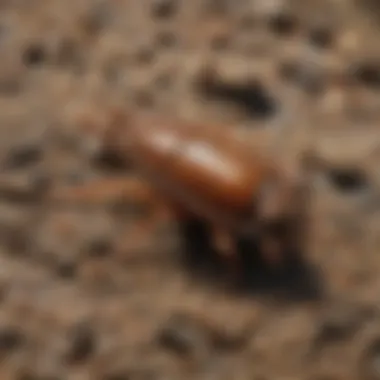Surveillance and Management: Pest Control in Surf City


Intro
In the vibrant environment of Surf City, pest management has become a paramount concern for homeowners and business proprietors alike. Understanding the local pest landscape not only aids in preserving property integrity but also enhances overall living conditions. As pests become more adept at infiltrating homes, it is crucial to recognize their presence, implement preventive measures, and explore treatment options effectively. This article will provide a comprehensive examination of pest control strategies tailored to the specific challenges encountered in Surf City.
Pest Identification
Identifying pests is the first step in any effective pest management strategy. In Surf City, various pests pose significant threats to both residential and commercial properties.
Detailed descriptions of common pests
- Termites: These wood-destroying insects can cause extensive damage if left unchecked. Termites usually are small, creamy-white insects that live in colonies.
- Ants: Species such as the odorous house ant and fire ant are prevalent. They often invade kitchens and can contaminate food.
- Rodents: Rats and mice can enter buildings seeking warmth and shelter. They multiply rapidly and can pose health risks.
- Cockroaches: These resilient pests thrive in warm, humid environments. They can spread diseases and trigger allergies.
Signs and symptoms of infestations
- Gnaw marks: Look for bite marks on wood or wires, indicative of rodents.
- Droppings: Pests like cockroaches leave droppings that resemble black pepper.
- Mud tubes: Termites create mud tubes to travel from their nests to food sources.
- Unusual sounds: Scratching noises in walls may suggest hidden mice or rats.
"The earlier you identify a pest problem, the easier it is to mitigate its effects. Ignoring the signs will likely lead to a larger issue."
Prevention Strategies
Effective pest prevention requires both vigilance and proactive measures. Homeowners can take simple steps to reduce the chances of infestations.
Home maintenance tips for pest prevention
- Seal entry points: Regularly inspect windows, doors, and foundation cracks.
- Maintain landscaping: Keep plants trimmed and away from the exterior of your home.
- Proper waste disposal: Store trash in tightly sealed containers to deter pests.
Natural deterrents and barriers
- Essential oils: Oils like peppermint or tea tree oil can naturally repel insects.
- Diatomaceous earth: This powder can be spread in problem areas to deter crawling insects.
Treatment Options
Once an infestation occurs, immediate action is necessary. There are various treatment methodologies to choose from.
Overview of chemical vs. natural treatments
- Chemical treatments: Insecticides and rodenticides can be effective but come with risks to human health and the environment.
- Natural treatments: Solutions such as traps, baits, and botanical insecticides can provide safer alternatives.
Step-by-step guides for DIY treatments
- For ants: Mix equal parts of boric acid and sugar. Place it in small containers in ant-prone areas.
- For cockroaches: Combine baking soda and sugar to create bait; place it in areas where you notice activity.
By understanding the pest ecosystem in Surf City and implementing appropriate strategies, individuals can effectively manage and mitigate pest-related concerns within their homes and businesses.
Prolusion to Surf City Pest Control
Pest control is a vital aspect of maintaining a healthy environment in Surf City. The presence of various pests not only threatens the structural integrity of homes but also poses risks to the health of residents. Understanding the significance of effective pest control can guide homeowners in creating safer living spaces.
Understanding the Importance of Pest Control
Pest control plays a crucial role in safeguarding both residential and commercial properties. It ensures that pests, such as insects and rodents, do not alter our living conditions unfavorably. The benefits include reducing the potential for disease transmission and minimizing damage to property.
One major benefit of pest control is its impact on health. Pests can carry pathogens that cause illnesses. For example, cockroaches can aggravate asthma conditions and spread bacteria that lead to gastrointestinal diseases. By consistently managing pest populations, these risks can be mitigated effectively.
Additionally, pest control preserves property value. A pest infestation can lead to costly repairs and renovations. For instance, termites can cause significant destruction to wooden structures. Regular pest inspections and management can prevent these issues before they escalate, thus conserving your investment in the long term.


Overview of Surf City's Pest Challenges
Surf City faces a variety of pest challenges due to its climate and geography. Conditions such as warm coastal weather create an ideal breeding ground for many pests. Termites are widespread, particularly affecting woodwork and foundations. Homeowners must remain vigilant to prevent infestations that can compromise their properties.
The area is also susceptible to insect varieties, including ants, roaches, and mosquitoes. Each of these pests brings its own set of challenges. Ant infestations can disrupt kitchens and pantries. Mosquitoes, on the other hand, pose serious health risks due to their ability to transmit diseases like West Nile virus.
Rodents, such as rats and mice, are another pressing issue. Their presence not only indicates unsanitary conditions but also raises concerns over food contamination and potential property damage.
In summary, understanding Surf City's specific pest challenges is critical for residents. Awareness prompts proactive measures that can help in maintaining not just personal comfort but also the overall safety of communities.
Types of Pests Commonly Found in Surf City
Understanding the types of pests that commonly invade Surf City is vital for effective management strategies. Pests can cause significant damage to properties, pose health risks, and create an uncomfortable living environment. Identifying these pests is the first step towards effective control and prevention. Awareness about these common nuisances can also aid homeowners in recognizing early signs of infestations, thereby mitigating potential damage before it escalates.
Identifying Termites and Their Impact
Termites are among the most destructive pests found in Surf City. They live in colonies and are primarily known for consuming wood, leading to structural damage and costly repairs. Their presence often goes unnoticed until considerable destruction has occurred.
To identify termites, homeowners should look for the following signs:
- Mud tubes: These are small tunnels that termites build to travel between their nest and food sources. They often cling to walls or foundation.
- Swarmers: Winged termites emerge when colonies are mature, typically during warm months, indicating an active infestation.
- Wood damage: Listen for hollow sounds when tapping wood. This can suggest termites have been feeding on it.
- Frass: This is termite droppings, appearing as small pellets, which can often be found near wooden structures.
Addressing termite infestations requires prompt action, as their destructive nature means that they can compromise the integrity of homes. Professional pest control services are often needed for effective resolution.
Insect Varieties: From Ants to Cockroaches
Several insect varieties plague Surf City and can disrupt daily life. Ants, especially, are common in the area. They often invade homes in search of food and can be difficult to eliminate. Certain species, like the carpenter ant, can also cause structural damage similar to termites.
Cockroaches pose another challenge. They thrive in warm, humid environments and can spread diseases. Identifying the presence of cockroaches can be done through:
- Droppings: Small, dark feces that can indicate a larger infestation.
- Odor: A distinct musty smell can suggest the presence of cockroaches.
- Egg cases: Look for small capsules that can be hidden in various locations around the house.
Effective control of these insect varieties often involves a combination of sanitation practices and pest control treatments.
Rodents: Risks and Control Methods
Rodents, particularly mice and rats, are another prevalent concern in Surf City. They are capable of causing damage to both property and health. Rodents can gnaw through electrical wires and insulation, leading to fire hazards, while their droppings can trigger allergic reactions and diseases.
For homeowners, being aware of rodent signs is essential. Look for:
- Gnaw marks: Chewed areas on furniture or wires indicate rodent activity.
- Nests: These can often be found in hidden areas, such as attics or basements.
- Tracks: Rodent footprints can sometimes be visible in dusty areas.
Managing rodent populations typically involves sealing entry points, maintaining cleanliness, and, in some cases, using traps or poisons. Effective control measures not only help in eradicating the pests but also in monitoring for future invasions.
Preventive Measures for Pest Control
Preventive measures play a crucial role in effective pest management in Surf City. By implementing various strategies, homeowners can minimize pest infestations before they occur. This proactive approach benefits not just the immediate environment but also the overall health of the home and its occupants.
With the right preventive strategies, households can avoid costly treatments and maintain a comfortable living space. Effective prevention limits the conditions under which pests thrive. Any pest control strategy should focus on understanding specific pests and their habits, as prevention is always better than dealing with an infestation.
Setting Up Physical Barriers
Setting up physical barriers is one of the most direct and effective preventive measures. This involves sealing potential entry points for pests. Common areas of concern include gaps around windows, doors, and the foundation of buildings. Utilizing materials like caulk and weather stripping can effectively block these access points.
Another strategy includes installing screens on doors and windows, which keeps insects like mosquitoes and flies out while allowing air circulation. If there are known areas of high rodent activity, consider using metal mesh to cover vents and other openings. The more gaps that are sealed, the less likely pests can enter the home.
Maintaining Clean Environments


A critical step in pest control is maintaining a clean environment. Pests are often attracted to food residues and clutter. Regular cleaning of kitchens, dining areas, and other living spaces is essential. This includes:
- Quickly cleaning up spills: Any spills should be addressed promptly to avoid attracting ants and other insects.
- Storing food properly: Use airtight containers for pantry items. This prevents not just insects but also rodents from accessing food sources.
- Removing clutter: Keeping areas organized minimizes places where pests can hide. This is true for both indoor spaces and outdoor gardens.
Regular trash disposal also helps. Ensuring that trash cans are sealed and emptied frequently can limit the attraction of pests.
Utilizing Natural Deterrents
Natural deterrents are increasingly popular for homeowners looking to maintain a pest-free environment without relying solely on chemicals. Certain plants are known to repel specific pests. For instance, planting marigolds can deter nematodes while peppermint plants keep mice and other rodents at bay.
Other natural deterrents include:
- Essential oils: Oils like peppermint, tea tree, and eucalyptus can repel pests. Use them in diffusers or mix with water and spray around entry points.
- Diatomaceous earth: This natural powder is effective against many pests. When sprinkled in areas where pests are likely to travel, it can act as a barrier, disrupting their exoskeletons.
- Vinegar solutions: Vinegar can be an effective way to clean surfaces while deterring pests. Its strong smell repels many insects, especially ants.
Each preventive measure discussed contributes to a larger strategy of pest control. Understanding these simple yet effective methods will empower homeowners to keep their spaces comfortable and pleasant.
Chemical Solutions for Pest Control
Chemical solutions play a pivotal role in the management of pests in Surf City. These treatments, when applied correctly, can effectively eliminate pest populations and protect properties from potential damage. This section will delve into the specifics of chemical treatments and the safety considerations inherent to their use.
Understanding Chemical Treatments
Chemical treatments encompass a wide range of products designed to target specific pests. Common formulations include insecticides, herbicides, fungicides, and rodenticides. Each of these chemicals works in distinct ways, either by disrupting biological processes or by creating physical barriers against pests. For instance, insecticides may work by interfering with the nervous system of insects, while rodenticides target the digestive system of rodents.
The choice of chemical often depends on the type of pest being managed. Homeowners must ensure that the selected treatments are suitable for the specific pests on their property, as this maximizes effectiveness while minimizing potential harm to non-target organisms. Additionally, many modern chemical solutions are designed to be less harmful to the environment, which aligns with the growing awareness of sustainable practices in pest control.
Safety Considerations with Chemical Use
While chemical solutions can be highly effective, safety considerations cannot be overlooked. It is essential for homeowners to read and follow label instructions carefully, as improper use may result in adverse effects on health and the environment. Some key safety measures include:
- Use Personal Protective Equipment (PPE): Always wear gloves, masks, and protective eyewear when handling chemicals. This minimizes exposure risk, ensuring that users stay safe during application.
- Avoid Treatment during Windy Conditions: Chemical drift can occur when applying treatments in windy weather, potentially affecting non-target areas and ecosystems.
- Store Chemicals Properly: Keep chemical solutions in their original containers, away from children and pets. It is also vital to store them in a cool, dry place to prevent degradation.
- Ensure Adequate Ventilation: For indoor applications, ensure that the area is well-ventilated to reduce inhalation risks.
Proper safety measures and adherence to guidelines can make a significant difference in the efficacy of chemical pest control, while safeguarding health and the environment.
Professional Pest Control Services
In Surf City, the landscape of pest control is shaped not only by the types of pests found but also by the methods used to control them. Choosing professional pest control services is a significant decision for homeowners and landlords. These services offer a blend of expertise, technology, and methods tailored to address pest issues effectively.
Engaging professional help can save time and provide efficient solutions that might be challenging for individuals trying to manage pest problems on their own. Pest control professionals possess specialized knowledge about the life cycles of pests and are trained to identify potential infestations before they escalate.
When to Seek Professional Help
When considering pest control, it is essential to discern when professional intervention is necessary. Some indicators include:
- Escalating Infestation: If you notice a rapid increase in pest populations, this is a clear signal for professional assistance.
- Persistent Problems: Continuing to experience pest issues despite DIY efforts suggests a need for expert evaluation.
- Health Risks: Pests can carry diseases or trigger allergic reactions. If your family’s health is at risk, it’s time to call in professionals.
- Property Damage: Pests like termites can cause significant structural damage, making early intervention vital to preserve your home’s integrity.
These various factors highlight the critical role that professionals play in managing pest issues effectively and safely.
Evaluation of Pest Control Providers
Choosing the right pest control provider requires careful evaluation. Key criteria include:
- Experience and Reputation: Investigate how long the company has been operating and look for reviews or testimonials from past clients. A company's reputation can provide insights into their effectiveness.
- Techniques Used: Inquire about the methods and products employed. Are they using environmentally friendly solutions? Understanding the approach can help clarify their practices.
- Licensing and Certifications: Verify that the provider is licensed and accredited by relevant authorities. This ensures they are qualified to perform pest control services legally.
- Service Guarantees: Customers should review what guarantees are offered regarding pest management. A reputable provider will often have follow-up services or warranties.
Evaluating these elements can lead to an informed decision, ensuring that your home is in the hands of competent professionals that align with your needs.
"Proper evaluation of pest control services ensures peace of mind, knowing your home is safeguarded effectively."


Regulatory Framework for Pest Control
The regulatory framework for pest control is essential within the context of this article. It serves as a vital foundation that governs how pest management is approached in Surf City. Understanding these regulations is crucial for homeowners and professionals alike. They inform responsible practices, ensuring the safety of residents while effectively controlling pest populations. Additionally, these guidelines help maintain the balance between effective pest control and environmental sustainability.
State Laws and Local Ordinances
State laws and local ordinances play a significant role in shaping pest control practices in Surf City. Each municipality has the authority to set regulations based on local needs and pest challenges. These laws can dictate which pest control substances are permissible, the certification required for pest control professionals, and the specific methods that can be employed. For instance, some local ordinances may prohibit certain chemical treatments due to their potential harm to the environment or human health.
It's important for homeowners to familiarize themselves with these laws. Non-compliance can lead to penalties or ineffective pest control solutions. Local regulations may also provide guidelines for the disposal of hazardous materials and the preservation of public health and safety. Therefore, when dealing with a pest issue, consulting your local pest control regulations should be a priority.
Environmental Regulations Impacting Pest Control Methods
Environmental regulations significantly influence pest control methods employed in Surf City. These regulations are designed to protect ecosystems, wildlife, and human health. They ensure that pest control practices do not inadvertently cause harm to the surrounding environment.
For instance, the use of certain pesticides is often regulated to prevent runoff into water supplies, which can pollute drinking water. Regulations may also require the use of integrated pest management (IPM) practices, which emphasize non-chemical alternatives and monitor pest populations before deciding to apply chemical treatments.
Understanding these regulations helps homeowners make more informed decisions. It encourages the adoption of sustainable pest control practices that prioritize the environment while still addressing pest issues effectively.
"Regulations shape how we approach pest management, balancing efficacy with environmental protection."
Ultimately, both state laws and environmental regulations are key components of a comprehensive pest control strategy. They provide a structured approach that ensures pest management is conducted safely, effectively, and sustainably.
Environmental Considerations
The growing attention towards environmental implications in pest control strategies is vital in Surf City. Understanding the balance between controlling pest populations and protecting local ecosystems resonates deeply with both residents and professionals engaged in pest management. Pest control methods, if not applied judiciously, can lead to unintended consequences for wildlife and plant life. It is essential to assess how various approaches to pest management intersect with the health of our surroundings.
Impact of Pest Control on Local Ecosystems
Every action taken to eliminate pests must acknowledge the complexity of local ecosystems. Pests often play roles within food webs, and chemicals or methods used for control could disrupt these natural interactions. For instance, targeting an invasive species like the brown marmorated stink bug may benefit crops, yet over-reliance on chemical insecticides can harm pollinators such as bees, which are already facing severe threats.
This disruption can also extend to soil health. Soil microbiomes, which are crucial for plant growth, can be adversely affected by the accumulation of residual chemicals. When considering pest control options, homeowners should be informed about the broader effects their choices may have on soil and ecosystem integrity.
Additionally, runoff from pest control treatments can enter local waterways, altering habitats and affecting aquatic life. There is a growing recognition of integrated pest management as a critical approach. This strategy combines biological control, habitat manipulation, and minimal chemical interventions to achieve pest control goals without compromising ecological balance.
Sustainable Practices in Pest Management
Promoting sustainable practices in pest management is not only beneficial for the environment, it ensures long-term effectiveness in controlling pest populations. One crucial principle is the use of integrated pest management techniques which emphasize preventive measures that reduce the need for chemical applications.
- Cultural Controls: This includes techniques that focus on changing farming or gardening practices to deter pests. For example, rotating crops can disrupt pests’ life cycles.
- Biological Control: Utilizing natural predators or parasites to manage pest populations is both effective and environmentally friendly.
- Physical Barriers: Installing screens or traps can help exclude pests without resorting to chemicals.
It is essential to educate homeowners about the availability of natural repellents and eco-friendly products. These alternatives offer effective pest control without the harmful side effects associated with many conventional pesticides.
Using sustainable methods fosters not only a healthy home environment but also the well-being of the broader community.
The End: Safeguarding Homes and Health
The topic of safeguarding homes and health through effective pest control is pivotal in maintaining not only a comfortable living environment but also the overall well-being of residents. Pest infestations can pose serious risks, including property damage and health concerns. Hence, an effective pest management strategy is essential for both homeowners and community members in Surf City.
A comprehensive approach to pest control encompasses preventive measures, effective treatments, and environmental considerations. Homeowners should invest in regular inspections and maintenance to identify any potential pest issues early. This foresight can significantly reduce the likelihood of larger infestations, which can be costly and difficult to manage. Moreover, it is important for house owners to remain informed about the types of pests that are common in Surf City, as well as the best practices for dealing with them.
Integration of sustainable practices in pest management not only benefits the immediate living conditions but also contributes to the ecological health of the area. Indeed, reducing reliance on harmful chemicals helps protect local wildlife and preserve the delicate balance of natural ecosystems. Therefore, community awareness and responsible pest management practices are crucial for enhancing the environment.
"An informed homeowner is the first line of defense against pests. Proactive measures and awareness can safeguard health and property."
This conclusion emphasizes the importance of continuous education and awareness in pest control practices. Engaging with local pest control services that adhere to regulatory frameworks can provide peace of mind to homeowners, instilling confidence that their health and property are protected.
Future Considerations in Surf City Pest Control
Looking ahead, pest control strategies will likely continue to evolve in response to a variety of factors. Advances in technology may introduce new methods of surveillance and pest management that are more effective and less harmful to the environment.
- Technological Innovations: Smart traps, remote monitoring systems, and data analytics will assist homeowners in early detection and effective handling of pest issues.
- Regulatory Changes: It's important to stay updated with local regulations that govern pest management practices, as these may shift to adapt to environmental considerations and public health guidelines.
- Public Awareness: Increased knowledge among homeowners about pests will lead to better preventive strategies and a community more engaged in pest management efforts.
In summary, constant learning and adaptation will be key in maintaining effective pest control in Surf City. Homeowners must remain vigilant and proactive to ensure they can protect their homes and health effectively.



